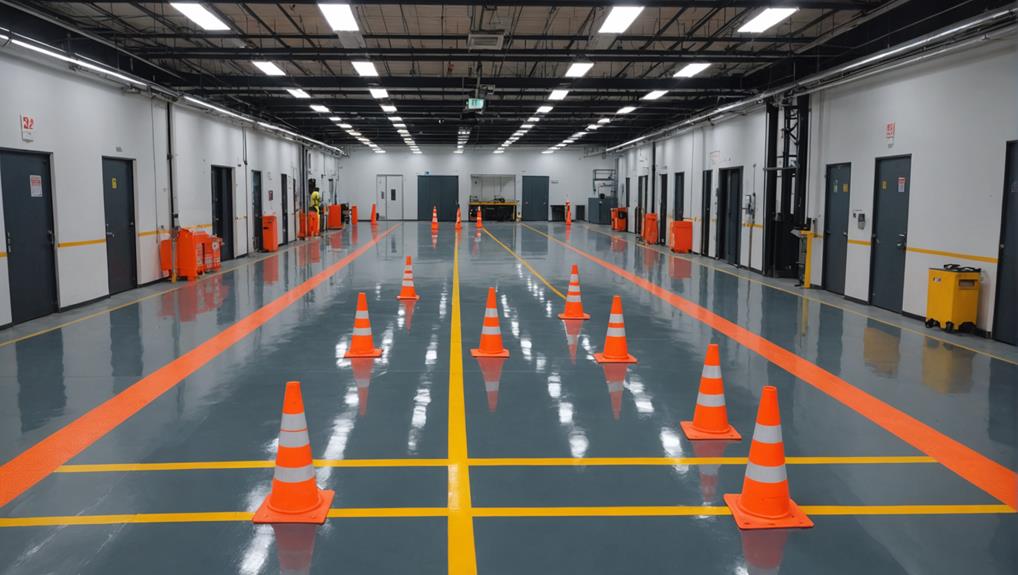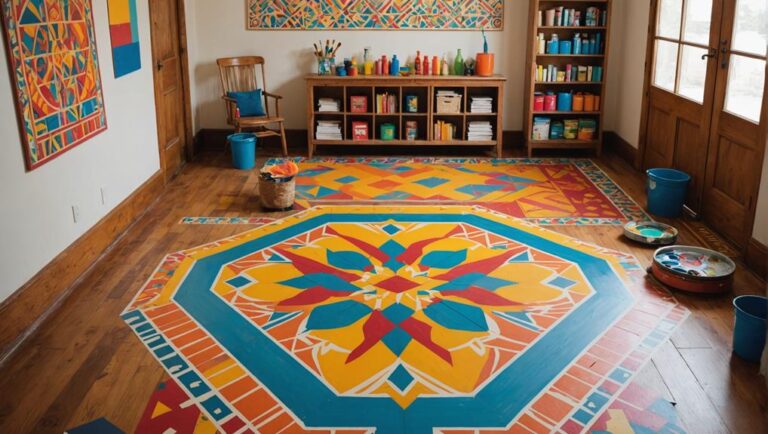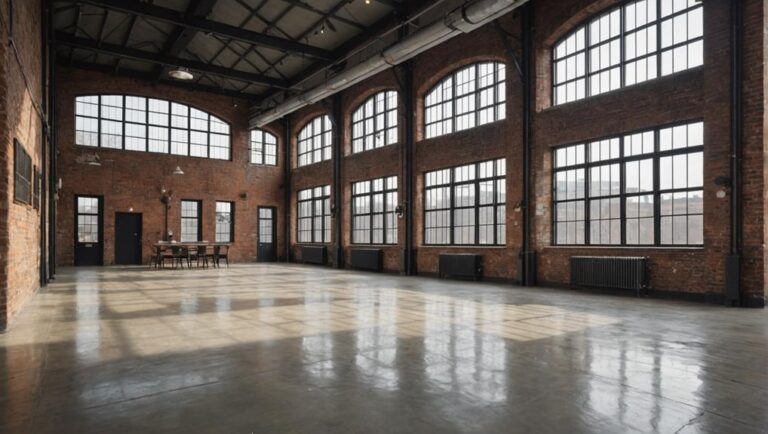To guarantee safety for flooring in industrial spaces, start by selecting durable, slip-resistant materials suitable for your work environment. Proper installation is essential, so always follow manufacturer guidelines and prepare the subfloor adequately. Regularly maintain cleanliness to prevent slips caused by spills or dirt. Conduct routine inspections to identify wear or potential hazards early. Implement clear signage to communicate risks effectively, and make sure it's regularly updated. Finally, train your employees on safety practices, including the importance of appropriate footwear. Understanding these safety measures can greatly enhance workplace safety and efficiency—there's much more to explore.
Choose the Right Material
When it comes to industrial flooring, choosing the right material can make all the difference. The flooring you select not only affects the safety of your workspace but also impacts the longevity of your investment. Prioritize material durability to guarantee it withstands heavy loads, chemicals, and everyday wear and tear. Options like epoxy, polished concrete, or vinyl can provide the resilience you need, but it's vital to evaluate the specific demands of your environment.
Another important factor is the environmental impact of your flooring choice. Many materials have varying levels of sustainability. For instance, some vinyl products emit volatile organic compounds (VOCs) that can compromise air quality, while others are made from recycled content, offering a more eco-friendly option. You'll want to opt for materials that contribute to a healthier workplace and align with your organization's sustainability goals.
Additionally, consider maintenance requirements. Some flooring types may need regular upkeep, which can affect your operational costs and safety standards. Investing in a durable material can reduce the frequency of repairs and replacements, ultimately leading to a safer environment.
Lastly, think about slip resistance. A flooring material that provides traction underfoot can greatly reduce the risk of accidents, especially in areas prone to spills or moisture. By carefully weighing these factors—material durability, environmental impact, and safety features—you'll be better equipped to choose flooring that not only looks good but also promotes a safer industrial workspace.
Ensure Proper Installation
Proper installation of industrial flooring is crucial for maximizing safety and performance. If you want to guarantee a durable and safe flooring solution, pay close attention to subfloor preparation and installation techniques. An improperly prepared subfloor can lead to uneven surfaces, which may increase the risk of slips and falls. Before installation, inspect the subfloor for any moisture, debris, or damage. It's essential to fix any issues and confirm that the subfloor is level, dry, and clean.
When it comes to installation techniques, follow the manufacturer's guidelines meticulously. Different flooring materials require specific methods for peak performance. For example, some materials may need to be glued, while others can be interlocked or floated. If you're not familiar with these techniques, consider hiring a professional installer who specializes in industrial flooring. They'll have the expertise to handle the complexities of the job, securing a safe and effective installation.
Additionally, make sure to allow for proper acclimation of the flooring material before installation. This step helps prevent expansion or contraction that could compromise the flooring's integrity after it's been laid. Always use the recommended tools and equipment to avoid unnecessary damage during the installation process. By focusing on proper subfloor preparation and utilizing the right installation techniques, you're taking significant steps toward creating a safe industrial environment. Remember, a well-installed floor not only enhances safety but also contributes to the longevity of your flooring investment.
Maintain Cleanliness Regularly
Even the best-installed industrial flooring can become a safety hazard if it isn't kept clean. Regular maintenance is essential for guaranteeing flooring hygiene, which directly impacts the safety of your work environment. Accumulated dust, debris, and spills can create slippery surfaces or hidden trip hazards, increasing the likelihood of accidents.
To maintain cleanliness, establish a routine industrial cleaning schedule. This should include daily cleaning of high-traffic areas, as well as periodic deep cleaning of the entire facility. Employ appropriate cleaning methods and equipment suited for your specific flooring type to avoid damage while guaranteeing effective cleanliness. For instance, avoid harsh chemicals that could degrade your flooring material or leave residues that may lead to slips.
Training your staff on proper cleaning techniques is equally important. Make sure they understand the importance of maintaining flooring hygiene and are equipped to handle spills immediately, preventing them from becoming larger issues. Encourage a culture of cleanliness, where everyone takes responsibility for keeping their workspace tidy.
Lastly, consider utilizing industrial-grade mats in areas prone to spills or heavy foot traffic. These mats can help reduce the amount of dirt and moisture that reaches your flooring, ultimately contributing to a safer environment. By prioritizing cleanliness and implementing consistent industrial cleaning practices, you can considerably reduce the risk of accidents and guarantee a safer workplace for everyone.
Implement Slip-Resistant Features
One of the most effective ways to enhance safety in industrial settings is by implementing slip-resistant features in your flooring system. By integrating these features, you can greatly reduce the risk of slips and falls, which are common hazards in workplaces.
Start by considering texture variations in your flooring materials. Textured surfaces provide better traction than smooth ones, making it more difficult for employees to slip, especially in areas prone to spills or moisture. Different textures can cater to specific needs, whether you're dealing with heavy machinery or pedestrian traffic.
Additionally, you should explore various surface treatments designed to improve slip resistance. These treatments can be applied to existing floors or incorporated into new installations. Options like anti-slip coatings, mats, or grit additives create a safer environment by increasing friction underfoot.
It's also essential to evaluate the specific conditions of your industrial space. For instance, if your facility often faces wet conditions, you might want to prioritize flooring materials with a high slip-resistance rating. Regularly consult with flooring experts to guarantee you're choosing the best options available for your unique needs.
Ultimately, investing in slip-resistant features not only protects your workforce but also contributes to overall productivity. Employees will feel safer, allowing them to focus on their tasks without the constant worry of potential accidents. Prioritize safety in your flooring decisions, and you'll foster a more secure industrial environment.
Regularly Inspect Flooring
Regular inspections of your industrial flooring are essential to maintaining a safe work environment. By regularly checking the condition of your flooring, you can identify potential hazards before they lead to accidents or injuries. Prioritizing flooring durability not only enhances safety but also extends the lifespan of your flooring materials, saving you money in the long run.
Determine an appropriate inspection frequency that works for your facility. Depending on the type of activity and foot traffic, you may need to conduct inspections daily, weekly, or monthly. During these inspections, be vigilant about the following:
- Cracks and Damage: Look for any visible cracks, chips, or areas of wear that could pose tripping hazards.
- Surface Conditions: Check for any signs of moisture, oil spills, or other substances that could make the floor slippery.
- Joint Integrity: Verify that expansion joints and seams are intact and not deteriorating, as these can be weak points in your flooring.
- Wear Patterns: Monitor areas that experience high traffic for unusual wear that could indicate a need for repair or replacement.
Use Proper Signage
Using clear warning signs is essential for maintaining safety in industrial flooring areas. They help communicate hazards and remind workers about necessary precautions. Regular maintenance updates should also be posted to keep everyone informed about any changes that could impact safety.
Clear Warning Signs
Although you may not always notice them, clear warning signs are essential for maintaining safety in industrial flooring environments. They serve as immediate indicators for hazard identification and remind employees of emergency protocols. Without proper signage, the risk of accidents increases considerably.
To enhance safety, verify your workplace features clear and visible warning signs that convey critical information. Here are some key aspects to reflect on:
- Visibility: Use bright colors and large fonts to guarantee signs are seen from a distance.
- Clarity: Use simple language and universally recognized symbols to convey messages quickly.
- Placement: Position signs at eye level and near potential hazards to catch attention.
- Maintenance: Regularly check the condition of signs; replace any that are damaged or faded.
Implementing these strategies can considerably improve hazard identification and help prevent accidents. Remember, effective signage not only informs but also empowers employees to act appropriately in emergencies. Prioritizing clear warning signs in your industrial space is a proactive approach to cultivating a safer work environment.
Regular Maintenance Updates
Maintaining industrial flooring requires consistent attention to detail, particularly in the use of proper signage. Effective signage plays an essential role in guaranteeing safety, guiding employees through potential hazards, and indicating areas requiring flooring inspections. By placing clear, visible signs throughout your facility, you can minimize the risk of accidents and keep everyone informed.
Regular maintenance scheduling is vital for preserving the integrity of your flooring. Establish a routine for inspections and updates, and use signage to remind staff about upcoming maintenance activities. This proactive approach not only helps in identifying wear and tear but also reinforces a culture of safety within your workplace.
When scheduling maintenance, make certain to communicate any changes or closures clearly through signage. Whether it's a temporary obstruction or a section needing repair, effective signage guarantees that employees remain aware and cautious.
Incorporating these practices into your daily operations will greatly enhance safety and efficiency. Remember, a well-maintained floor is a safer floor, and proper signage is an integral part of that maintenance strategy. Stay vigilant, and make safety a priority in your industrial space.
Train Employees on Safety Practices
Training employees on safety practices is essential for creating a secure work environment, particularly in areas with industrial flooring. When your team is well-informed about safety protocols, it greatly reduces the risk of accidents and injuries. Implementing regular training sessions not only enhances employee engagement but also fosters a culture of safety. Here are some key components to include in your training program:
- Safety Drills: Conduct regular safety drills to guarantee everyone knows what to do in emergencies. This reinforces knowledge and builds confidence.
- Proper Footwear: Educate employees on the importance of wearing appropriate footwear to prevent slips, trips, and falls on various flooring types.
- Hazard Awareness: Train employees to identify potential hazards in their work environment, encouraging them to report issues before they escalate.
- Equipment Safety: Provide guidance on the safe use of equipment and machinery, emphasizing the importance of following the manufacturer's guidelines.
Frequently Asked Questions
What Are the Most Common Flooring Materials Used in Industrial Spaces?
In industrial spaces, the most common flooring materials include concrete, epoxy coatings, and rubber. Concrete is durable but often requires additional treatments for slip resistance. Epoxy coatings are popular for their ability to create a seamless, strong surface that enhances safety. They provide excellent slip resistance, making them ideal for high-traffic areas. Rubber flooring is also used for its cushioning and traction properties, ensuring a safer environment for workers handling heavy machinery or equipment.
How Often Should Flooring Inspections Be Conducted?
You should conduct flooring inspections at least once a month, especially in high-traffic areas. Regular inspection frequency is essential for identifying wear and tear early, allowing for timely flooring maintenance. This proactive approach helps prevent accidents and guarantees the flooring remains safe and functional. If your space is subject to heavy loads or spills, consider increasing the frequency to every two weeks. Consistent inspections are key to maintaining a safe environment.
Are There Specific Regulations for Industrial Flooring Safety?
Yes, there are specific regulations for industrial flooring safety. You need to guarantee regulatory compliance with the standards set by organizations like OSHA and ANSI. These standards address slip resistance, load capacity, and surface durability, vital for preventing accidents in industrial settings. Regularly reviewing these flooring standards helps maintain a safe environment for employees. Always stay updated on any changes in regulations to keep your workplace safe and compliant.
Can Flooring Choices Impact Employee Productivity?
Did you know that 80% of employees feel more productive in environments where flooring is both aesthetically pleasing and ergonomic? Your choice of flooring can greatly impact productivity. Ergonomic benefits, like reduced fatigue and improved comfort, enhance focus and efficiency. Additionally, appealing flooring aesthetics can create a more inviting workspace, boosting morale. By prioritizing these aspects, you're not just ensuring safety; you're actively fostering a productive and engaging work environment for your team.
What Should I Do After a Slip or Fall Incident?
After a slip or fall incident, it's essential to act quickly. First, guarantee the injured person gets appropriate medical attention. Then, document the incident thoroughly, including details and witness accounts for incident reporting. Make certain to review your workplace's safety protocols and provide additional employee training if needed. This helps prevent future occurrences and reinforces the importance of safety. Always prioritize creating a safe environment for everyone involved.




